Your cart is currently empty!
Author: admin
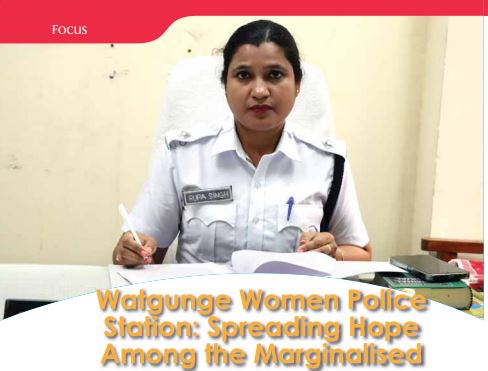
Watgunge Women Police Station: Spreading Hope Among the Marginalised
Inaugurated seven years ago, the Women Police Stations in Kolkata have been a great success in ensuring the safety and security of women in the city. Thanks to their efforts, Kolkata has become the safest city in India for the third consecutive year, as per the annual report released by the National Crime Records Bureau. Kolkata has the lowest number of cognisable offences per lakh population among all the metropolises in India.
Watgunge Women Police Station was among the first four to be established. It is situated within the same premises as the Watgunge Police Station. It is responsible for covering the entire area under the Port Division, including North Port, South Port, Watgunge, West Port, Garden Reach, Ekbalpur, Nadial, Rajabagan and Metiaburuz.
Led by Officer-in-Charge Rupa Singh, the all-female team of Watgunge Women Police Station is doing a remarkable job in fulfilling their duties as responsible police personnel.
Considering the demographics and literacy rate of the citizens living in this area of the city, the main challenge lies in the awareness perspective. According to OC Rupa Singh, “Our goal as police officers is to provide effective and smart policing with a humane approach. We have noticed that women in this area actively participate in our initiatives. We emphasise counselling in most cases of domestic disputes and misunderstandings, and we have been immensely successful in resolving these issues. However, we never compromise on the safety and security of women. This approach has been the hallmark of Team Watgunge Women Police Station.”
Rupa Singh is a 2008 batch officer who has always been known for her strict work ethic. In one of her interviews, she candidly shared about her early days in the police force. She used to live in the Hindmotor area of Hooghly and had to travel daily to and from work. None of her family members were part of the police fraternity. During the police verification process for her job, she visited a police station for the first time in her life. She had doubts about whether joining the police force was a wise decision or not. However, after 16 years of working in the Force, she believes that it was indeed the best decision of her life.
Rupa Singh became a Sub Inspector at the Amherst Street Police Station in 2009. She later worked at the Watgunge Police Station for two years until the inauguration of the Watgunge Women Police Station, where she was then transferred. Following this, she worked as a Sub Inspector at the New Market Police Station in the Central Division. In 2021, Rupa Singh was promoted to Inspector and joined the Detective Department. In 2022, she was assigned as the Officer-In-Charge of the Watgunge Women Police Station.
Rupa Singh’s experience and expertise have been honed through years of dedication and hard work. She recalled an incident from her early days at Amherst Street Police Station, where they received a missing complaint from a married woman from a nearby locality. That very evening, they found a lady roaming hopelessly on the road and later identified her as the missing woman. During her conversation with the lady, Rupa was astonished to know that the woman had earlier complained of domestic violence, but for some reason, the complaint was withdrawn afterwards. This incident came as a huge shock for Rupa and made her realise that as responsible women officers, they have enough scope to dig the truth with a humanitarian approach.
In another instance, Rupa Singh talked about how the safety of women is often associated with cybercrime. She narrated an incident from her time at Watgunge Police Station, during which, while patrolling in the early morning hours, they found an unconscious woman at an under-construction building. The lady, belonging to an underprivileged section of society, used to work as a mason. She was sexually assaulted and robbed of her mobile phone and other belongings by a man. The police did not have any lead except for her mobile phone, which was switched off for the next thirty days. On the thirty-first day, the phone started ringing, and they tracked it to Srirampur. They pursued it and eventually caught the culprit, who had sold the phone. Interestingly, the sketch of the culprit provided by the lady did not match the person who was caught. This happens when a person is traumatised. This incident was a significant lesson for Rupa Singh.
It is interesting to note that the Nayi Disha initiative implemented by the Port Division has had a positive impact on the Watgunge Women Police Station. Awareness programmes are conducted under this scheme in schools, colleges, slum areas, rickshaw stands, and other public interest areas. It has successfully educated people about child marriage, domestic violence, the importance of education, and the legal rights of citizens. It is worth mentioning that the Nayi Disha initiative was initiated under the leadership of the former DCP of Port Division, Kolkata Police, Zafar Ajmal Kidwai, IPS.
Women from local minority families have actively participated in community development projects of the Kolkata Police. Moreover, the Watgunge Red Light area has also seen a positive transformation, which can be attributed to the visible presence and professionalism of the police force.
Officer-In-Charge Rupa Singh signed off with these words, “We have been truly vigilant in the true sense of the term. Livelihood is a major area of concern for many women. We are actively working with non-profit groups to empower them. We believe that an inclusive community’s well-being is essential for progress. We can only hope that the Watgunge Women Police Station will serve as a great example for other Women Police Stations operating in the country in the coming days.”
Deciphering the Mullick Ghat Flower Market Murder Mystery
Every investigation demands meticulous precision and diligence. Irrespective of the severity of the crime, the Kolkata Police Department operates with dynamic teamwork.
Consider the case of State vs Tara Chand Sonkar, also known as Raja Sonkar. The incident dates back to the afternoon of October 3, 2014, during the Nabami celebration of Durga Puja, when a gruesome incident unfolded near Mullick Ghat Flower Market, turning it into a blood-stained crime scene which resulted in the loss of life.
Lakhi Mukherjee, or Phuli, as she is affectionately known in the Mullick Ghat Flower Market, was resting with her granddaughter, Neha, in their home on Stand Bank Road near Howrah Bridge. A man named as Raja Sonkar, allegedly involved in a romantic liaison with Phuli, entered her home and had a verbal abusive confrontation with her. The neighbourhood knows Phuli for her Bahubali image or strong demeanour. Raja, visibly upset with reasons known only to him, attacked Phuli with a hasua or sickle from the corner of the room. Phuli narrowly avoided a fatal blow from the sickle wielded by Raja Sonkar. However, Neha and Phuli’s cries alerted others. This prompted Raja Sonkar to flee. Meanwhile, Bijoy, an orphan boy, was asleep on a camp cot downstairs, positioned on the verandah’s southern side adjacent to the building. As he was rushing out from the house, Raja Sonkar dealt a fatal blow to Bijoy’s throat with the sickle. He immediately fled towards the Howrah Bridge after the vile attack.
Following the incident, the victims – Bijoy and Phuli – were taken to the Medical College, where Phuli survived after treatment, while Bijoy was declared brought dead by the attending doctors.
The ensuing investigation, referenced as North Port Case No. 92 dated October 3rd, 2014, U/S 302/307 IPC, was spearheaded by the Homicide Squad of the Detective Department, Kolkata Police.
On November 17th, 2014, Raja Sonkar was apprehended from BK Pal Avenue and Rabindra Sarani Crossing. Subsequently, on November 27, 2014, blood-stained clothing linked to the crime was recovered based on his confession.
Further investigation revealed an illicit relationship between Raja Sonkar and Phuli. Raja Sonkar suspected that Phuli also had a relationship with the victim Bijoy.
A charge sheet was filed against Raja Sonkar on February 4, 2014, US 302/307 IPC well within the stipulated period, with Sub Inspector Sandip Pramanick as the Investigating Officer (IO) of the case.
The trial proceeded at the court of the Ld 2nd FTC, Bichar Bhawan, Kolkata, with Raja Sonkar in custody. Over the course of the trial, 22 prosecution witnesses were examined. On December 4, 2023, the court adjudged Raja Sonkar guilty under Sections 302/324 IPC.
On December 5, 2023, Raja Sonkar received rigorous life imprisonment and a fine of Rs 10,000, i/d six months imprisonment U/S 302 IPC, and RI for one year U/S 324 IPC. These sentences are to run concurrently, as pronounced by Shri Anindya Banerjee at the Ld 2nd FTC, Bichar Bhawan, Kolkata. l
Details provided by:
Homicide Squad, Detective Department, Kolkata Police.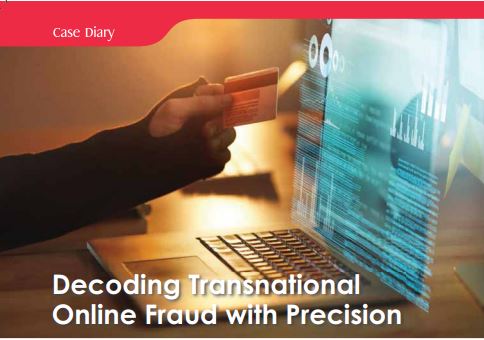
Decoding Transnational Online Fraud with Precision
Traditional crime may seem like a relic of the past in today’s digital age. The rapid digitisation has revolutionised the landscape of criminal activities, blurring the lines of traditional demographic boundaries. Kolkata Police is at the forefront of adapting to this paradigm shift, showcasing groundbreaking investigations into cybercrime.
A recent case demonstrates this transformation: a sophisticated digital fraud targeted at a US citizen, highlighting Kolkata Police’s adeptness in combating cybercrime and digital malfeasance. The Federal Bureau of Investigation (FBI), through CBI (Interpol – New Delhi), relayed crucial information to Kolkata Police regarding individuals impersonating as Norton employees. These imposters prepared fraudulent electronic documents, presenting them as genuine to deceive unsuspecting victims into making payments under false pretenses of providing legitimate technology support. In this instance, an elderly US citizen was defrauded a staggering $85,786.57 through an online banking transaction.
A case was registered at the Cyber Police Station, Lalbazar Head Quarter. (Ref: Case No. 122/22 dt. 01.11.2022, U/S-66/66C/66D read with Section 43 Information Technology Act 2000, and Sections 120B/420/467/468/471 IPC since amended U/S 306 IPC. The complainant was Raja Saha, Sub-Inspector of Police, Cyber Police Station, Kolkata Police Lalbazar Headquarters. The four accused in the case were Shizan Ali Haider, Md Atif, Subtain Ali Haider and Syed Tarique Kalam.
During the investigation, it was discovered that the IP address under scrutiny was registered to Alliance Broadband, a local service provider in Kolkata. On January 3, 2023, authorities conducted a raid at V. God Cafe, located within the Tiljala Police Station area. Shizan Ali Haider, the individual to whom the IP address was allocated by the broadband service provider, was apprehended after he refused to cooperate with law enforcement and declined to present his identification. Following proper legal procedures, he was arrested after interrogation.
On January 19, 2023, acting on gathered intelligence, another raid was carried out at Anjuman Road in Beniapukur, resulting in the arrest of Md Asif. Further investigation unveiled that the perpetrators were utilising multiple identities, including two GMail accounts. Authorities reached out to Google, which provided crucial information linking a phone number to the GMail accounts, leading to the identification of Subtain Ali Haider. He was arrested from a hotel in Ajmer, Rajasthan, on January 22, 2023.
Similarly, leveraging information provided by Google about the other GMail account, authorities tracked down Syed Tarique Kalam, who was ultimately arrested on February 10, 2023, in Pune.
Given that the victims in this case were from abroad, digital evidence played a crucial role in the investigation. Two of the foreign nationals gave their deposition before the judge, shedding light on the gravity of the situation. Shockingly, one victim revealed that the accused had incited her husband to take his own life, prompting the inclusion of Section 306 IPC alongside the existing charges.
Further inquiries revealed that all the accused were part of an extensive criminal network, operating across West Bengal and other States. The charge sheet in the case was submitted on April 17, 2023.
Inspector Shukla Sinha Roy led this intricate investigation, which demanded extensive coordination across borders and meticulous attention to every detail, whether physical or digital. She deservedly earned the esteemed Cyber Cop of the Year Award, a testament to the exceptional capabilities of the Kolkata Police. l
Details provided by:
Cyber Police Station, Lalbazar Headquarters, Kolkata Police.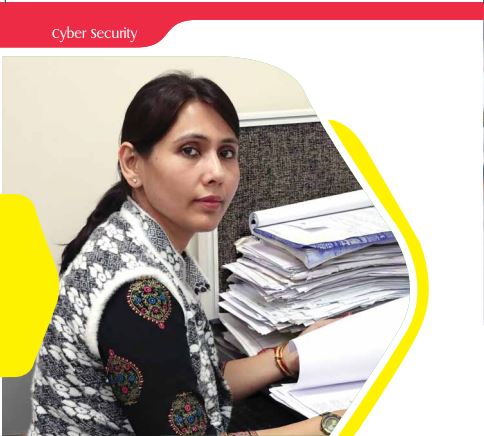
HEROES AMONGST US Inspector Shukla Sinha Ray: The Cyber Cop of India
The Kolkata Police has been receiving recognition for its dedication and commitment to the citizens of the City of Joy. Most recently, Inspector Shukla Sinha Ray of Lalbazar Cyber Police Station was named the joint winner, along with an officer from Telangana, as the country’s top cyber cop.
The award was jointly organised by the Data Security Council of India (DSCI) and NASSCOM in Gurugram. The Cyber Security Conference took place from December 19-21, 2023. Inspector Shukla Sinha Ray was declared co-winner of India’s Top Cyber Cop, surpassing stiff competition from police departments across the country.
Shukla Sinha Ray was honoured for her investigation into a fake call centre case flagged by the Federal Bureau of Investigation (FBI) after a US citizen committed suicide after losing money to fraudsters. Renowned for her professionalism and diligence, she exemplifies dedication and capability in uniform.
Shukla Sinha Ray was born into a family of a distinguished police officer. She joined the police force after successfully clearing the examination. A member of the 2004 batch, she served in various roles including Traffic Training School (TTS), Special Branch (SB), Shyampukur Police Station, and New Market Police Stations. In 2018, she transitioned to the Cyber Police Station in Lalbazar. Reflecting on her experience, she noted, “When I joined the Cyber Department, complaints about cybercrime were minimal. Until 2019, most cases involved WhatsApp and other social media platforms, where culprits used victims’ photos for sextortion or with malicious intent. However, the COVID era brought significant changes. With the rise of Work from Home (WFH), users’ digital engagement skyrocketed, leading to a paradigm shift in cybercrime worldwide.”
Rapid digitisation has provided an avenue for scammers and fraudsters to enter the cybercrime domain. Undoubtedly, this domain is more prevalent than traditional crime throughout India today.
The Cyber Police Station in Lalbazar has set a high standard for swift and efficient investigations, thanks to diligent police officers like Inspector Shukla Sinha Ray. She explains, “The process of conviction and prosecution differs in cybercrime. Electronic evidence often plays a decisive role. Moreover, with social media and other platforms whose servers are located outside India, international coordination is crucial, though time-consuming. Fortunately, in the Call Centre case flagged by the FBI, the coordination was seamless, with witnesses and individuals joining online from different time zones. We are fortunate to have such a fantastic team of officers in Kolkata Police, well-versed in digital aspects. Kolkata Police has undoubtedly set a benchmark in cyber policing.”
Deciphering cybercrime poses significant challenges. In 2019, the Cyber Police Station in Lalbazar faced a unique case: a victim received a threatening message on WhatsApp containing her nude photo from an unknown number, demanding Rs 10 Lakhs to prevent its online dissemination. With minimal clues beyond the number, Inspector Shukla Sinha Ray recounts, “We initiated our investigation from scratch. WhatsApp’s delayed response hindered progress. The victim clarified that she had not sent the photo to her boyfriend, ruling out his involvement. After meticulous investigation, we apprehended the culprit in Bihar.”
Inspector Shukla Sinha Ray’s exceptional contributions earned her the Indian Cyber Cop award, making her the first woman to receive this honour. Hopefully, her achievement will inspire more women to join the uniformed services, ensuring the safety and security of citizens.
We extend our best wishes to Shukla Sinha Ray for her future endeavours as a dedicated member of the Kolkata Police Force.
Artificial Intelligence and Investigation
Bivas Chatterjee is the Public Prosecutor for Cyber Law and Electronics Evidence for Government of West Bengal
What is Artificial Intelligence?
Simply put, Artificial Intelligence (AI) is a technology possessing the same cognitive human abilities similar to humans. It can think, act, and make decisions like us.
The Journey
We travelled from enigma machine in 2nd world war era to these days’ AI. AI has both the possibilities for good as well as can be used for evil purposes. AI is our next master. We are in a juncture where we are handing over control of our life to our next super human, of course made by men. It has already become more intelligent than ordinary human being.
The development from the Enigma machine of the Second World War era to the present AI represents a remarkable journey in human technological advancement. AI indeed holds tremendous potential that has beneficial and detrimental outcomes. We are at a critical juncture where control of our lives is increasingly handed over to AI, a machine, ironically created by humans, but has evidently surpassed ordinary human intelligence.
Why Worry?
Much like other innovations, Artificial Intelligence has positive and negative repercussions. However, the primary issue is not with AI itself, but the competitive greed and drive that lead people to develop it for detrimental purposes. For instance, Deepfake technology can impersonate individuals – be it a common man or a high-profile individual – so convincingly that it has become almost impossible to differentiate between the original and deepfake. Another example is the invention of ChatGPT. Within two months of its existence, it was downloaded by more than 100 million people worldwide. AI’s rapid adoption underscores its potential to provide swift and resourceful assistance while also raising concerns about its misuse and impact on society.
Weaponising AI for Criminal Activities
The rise of AI scams is a concerning trend. One can be randomly targeted through a phone call or be threatened with manipulated videos or voice recordings of their loved ones for the evil intent of seeking a ransom. A notable incident occurred in the USA whereby a false kidnapping attempt was planned to extort millions of dollars by replicating the daughter’s voice. The increase of deepfakes, particularly pornographic material, draws attention to the dangers of AI misuse.
AI-generated art are already posing a serious challenge to artists and creators. The latest version of ChatGPT (ChatGPT-4) is estimated to have an IQ of 155, almost equalling renowned scientist Einstein’s IQ of 160. With AI capabilities continuing to show no sign of slowing down, but is surpassing human brain speed by thousands of times, there is growing uneasiness about the high cost of a global destruction driven by human greed.
Role of AI in Investigations
Predictive Policing:
Suitable search engine can predict the probable solution of investigation and prevention of crimes, crime analysis and solution by using the data which are fed in AI. However, it is crucial to acknowledge the potential for discrimination in such systems.
By applying appropriate AI powered analysis, the following parameters of effective policing can be done.
Forecasting:
ii) Time and place where crime is on the rise.
iii) A group of people likely to be victims or perpetrators.
iii) Predictive individuals who may be victims, namely senior citizens, etc.
iv) Predictive individuals who may be involved in criminal activities
CCTNS data can help in better crime prediction if used with proper AI algorithm.
Data analysis plays a crucial role in predictive policing initiatives such as the surveillance matrix in Himachal Pradesh and facial structure analysis at airports to identify fraudsters.
Developed countries have successfully utilised AI technology to revisit old cases, resulting in solving old, cold and unsolved crimes.
AI can be used for forensic purposes as well. Recent GSR analysis of crime scenes in the UK has proven that AI will solve many unsolved criminal cases in the future.
AI-Driven Crimes
The rise of AI poses a significant threat to human superiority, deepfake videos and cloned voices are just some of the basic examples of what this technology can do to destroy us.
Cyber criminals are increasingly using AI to commit crimes. Let us examine some of them.
1) Cloned voices used to generate fake audio can be used to defraud people.
2) Cloned video or audio may be used in the commission of crimes.
3) Deepfake technology can be used to commit crimes or scam people.
4) AI-powered surveillance can cause great harm on individual privacy and safety. Surveillance data at the hand of fraudsters can cause huge damage to a person.
5) Manipulation of human behavioural by AI-engineered algorithm is a growing threat in political or advertising arenas.
6) Piracy and plagiarism-related offences.
7) Gender bias.
8) Automated hacking tools powered by AI to commit crime.
9) Manipulation in financial market by AI algorithm, especially in high frequency trading.
10) Spread of misleading information in every aspect of society, including the trading and financial industry.
11) Ethical concerns on autonomous weapon systems powered by AI and AI-powered military systems.
12) AI-powered social engineering (use of manipulative or deceptive tactics to entice unwitting victims to do something they won’t normally do) by manipulating human behaviour resulting into their victimisation. Personal data using AI can make social engineering more powerful.
13) AI-based malware threatens digital system.
14) AI-based propaganda to influence public opinion.
Few Examples of
AI-Enabled Frauds
1) A 15-year-old girl on a skiing holiday had her voice replicated by fraudsters, who then called her parents demanding a ransom of one million dollars. Despite the voice sounding just like her, it was AI-generated. The parents later came to know that their daughter was not in the custody of the kidnappers.
2) An elderly person in Ghaziabad was duped Rs, 74,000 by fraudsters who used deepfake to impersonate a former police officer, who called the elderly man asking him for money.
3) A man in Lucknow lost Rs. 45,000 when he was duped by a fake voice using AI, which impersonated his relative’s voice.
4) A woman in Noida was cheated of Rs. 11 Lakhs when she underwent a fabricated interrogation through Skype in connection with a money laundering case.
5) A person from Kerala was cheated to the tune of Rs. 40,0000 due to an AI-enabled deepfake scam with a false plea that his relative is in hospital and needed help.
6) An elderly person from Delhi was cheated of Rs 50,000 through a voice cloning fraud
7) As reported in the South China Morning Post, a company was duped a staggering Rs 200 Crores by a fake video call impersonating the CFO by using using deepfake technology.
8) Recently, American popstar Taylor Swift also became a victim of the malicious deepfake when vulgar videos of her were posted on various social media platforms.
Legal Acts and Regulations Related to Artificial Intelligence (AI)- The European Union’s Artificial Intelligence Act (AI Act) enacted on March 13, 2024.
- The European Parliament’s Ethical Principles Framework on AI development, deployment, and use.
- Various States in the USA, namely Colorado, Florida, Idaho, Maine, Maryland, Rhode Island, Vermont, and Washington, have passed laws related to AI.
- The United States National Artificial Intelligence Research Resource Task Force Act, passed on March 2024.
- Singapore’s Model AI Governance Framework.
- Canada’s Directive on Automated Decision-Making, to ensure whether AI systems are fair, unbiased, and respect human rights.
- Japan’s AI Utilisation Promotion Act.
- The Indian Government issued an advisory to social media platforms or intermediaries to identify and remove misinformation and deepfakes within 36 hours of reporting.
The Need of the Hour
AI security will be the need of the hour in the near future.
Immediate control on AI-engineered application with respect to their ethical as well as legal aspect affecting human mankind.
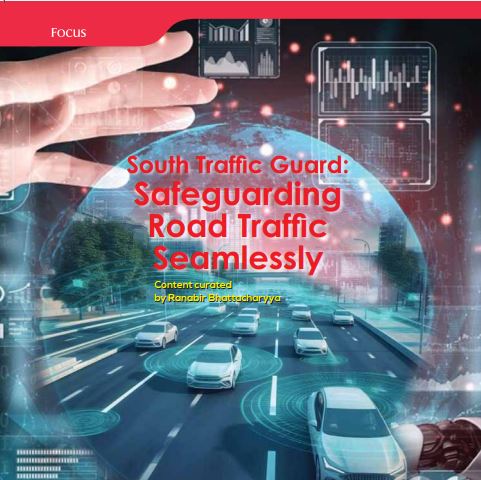
South Traffic Guard: Safeguarding Road Traffic Seamlessly
Content curated
by Ranabir BhattacharyyaThe South Traffic Guard caters to a very vital area of Kolkata under the jurisdiction of Kolkata Police. It maintains constant liaison with the Headquarters Traffic Guard. Along with that, it is constantly in touch with the Sealdah Traffic Guard in the North; Park Circus and East Traffic Guard in the East; Bhowanipore Traffic Guard in the South and Vidyasagar Traffic Guard in the West for running day-to-day traffic and the seamless movement of vehicles.
The South Traffic Guard has been operating from its present location since 1991. Previously it used to operate from where the present South East Traffic Guard is located. Covering an estimated area of 4.02 sq km, it encompasses several historical landmarks such as the Victoria Memorial Hall, the Sahid Minar, the Asiatic Society, and the Indian Museum. The jurisdiction of the South Traffic Guard includes over ten educational institutions, multiple hospitals, and private nursing homes. With four wards of the Kolkata Municipal Corporation (KMC), the population density is notably high, encompassing both residential and office areas. The area is also characterised by multiple market complexes, cinema halls, theatres, art galleries, and places of worship, resulting in a consistently high volume of vehicular movement. The South Traffic Guard operates closely with several police stations, including Hastings, Maidan, Park Street, Shakespeare Sarani, Hare Street, and New Market, all falling within its geographical coverage.
Under the supervision of the Kolkata Traffic Police management, the South Traffic Guard has taken multiple steps to reduce road accidents and ease traffic congestion. Based on the road traffic statistics, accident-prone roads and black spots have been identified. To reduce traffic congestion and fatal accidents, the South Traffic Guard has taken various developmental steps. First and foremost, cutouts along the busy Jawaharlal Nehru Road have been reviewed regarding crossover. Go slow guard rails with high-quality reflectors at respective crossings have been placed to ensure pedestrian movement and reduction of vehicular traffic. Drop gates have been installed at Exide Crossing and Birla Planetarium Crossing for smooth pedestrian crossover. Additionally, RLVD (Red Light Violation Detection) Cameras with ANPR (Automatic Number Plate Recognition) cameras have been installed at various strategic crossings under the South Traffic Guard. Speed indicator boards have been duly installed at multiple areas to create awareness among the citizens to stop incidents of overspeeding and rash driving. Speed limits have been duly notified for AJC Bose Road Flyover and the Park Street Flyovers to avoid any sort of mishaps.
Nilesh Choudhury, Officer-In-Charge, South Traffic Guard, remarked, “Our team at South Traffic Guard is dedicated to managing road traffic day and night, in the best interests of the citizens. Over the years, the volume of vehicles has significantly increased. Being a veteran in the traffic police fraternity under the Kolkata Traffic Police, we are presently using sophisticated technical gadgets for traffic management, including AI and body cameras. We conduct year-long activities and community engagement programmes to raise awareness. The ‘Safe Drive, Save Life’ campaign has been extremely instrumental in this regard. As a team, we make it a point to focus on prosecution and enforcement to ensure road safety.”
A very competent and diligent officer with many decades of experience, Nilesh Choudhury has been a stalwart in traffic policing in Kolkata Police. He has closely seen the evolution in traffic policing. In his own words,”To be a traffic police personnel is not easy. The demands of the job are hectic. But make no mistake, the job satisfaction is immense. I am proud to be an integral part of the growth of the city. We work in a closely-knitted team where the feedback of all the officers is given maximum importance. Furthermore, close coordination with all the stakeholders of the traffic ecosystem enables prior planning in traffic policing.”
Nilesh Choudhury started his policing career with the Headquarter Traffic Guard before serving in multiple capacities at the Vidyasagar Traffic Guard, Howrah Bridge Traffic Guard, Kasba Traffic Guard, and East Traffic Guard. “I am almost on the verge of completing three decades in the Kolkata Traffic Police. There are many unforgettable incidents. After the Majherhat Bridge collapse incident, the way the entire police force came together and mobilised the rescue operation remains a classical example of how our Force has excelled in all situations. We are always ready for all scenarios. The high level of preparedness makes the Kolkata Police the best one in the country,” signs off Officer-In-Charge Nilesh Choudhury, with his usual determination and spirit.
It is indeed a mammoth task for the South Traffic Guard to monitor and supervise the numerous vital installations and VVIP movement throughout the day. However, with a dedicated team comprising Inspectors, Sergeants, Assistant Sub Inspectors, Constables, Home Guards and Civic Volunteers under the leadership of the Officer-in-Charge, the South Traffic Guard has earned laurels across various quarters for its smooth functioning. We wish them all the very best in all their future endeavours in serving the citizens at large.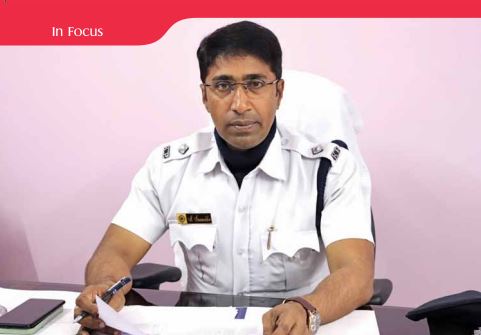
Bhangar Traffic Guard: Promoting Traffic Compliance in Bhangar
The Bhangar Traffic Guard is the newest addition to the Kolkata Traffic Police. It is an essential part of the newly established Bhangar Division, which marks the tenth division of the Kolkata Police.
Located at the meeting point of three districts – Kolkata, North 24 Parganas, and South 24 Parganas – Bhangar occupies a unique geographical position. With its 19 Gram Panchayats, it stands out from other areas under Kolkata Police jurisdiction. Bhangar, Ghatakpukur, and nearby regions are mainly rural.
Previously, traffic enforcement in such areas was not strict. However, with the establishment of the Bhangar Traffic Guard, this is changing. By using technology and a systematic approach to law enforcement, the Kolkata Traffic Police has built a reputation as one of the country’s most technology-friendly agencies for efficient road traffic management.
The main goal of the Bhangar Traffic Guard personnel is to educate citizens about traffic rules and regulations on a large scale. Initially, they prioritised raising awareness over prosecution, approaching the issue from a humanitarian standpoint. Their efforts in traffic management in Bhangar have received widespread praise from the local community.
The Officer-In-Charge of the Bhangar Traffic Guard, Middya Imamuddin, a highly experienced individual in traffic management, stated, “It’s always a challenge to enforce traffic rules in a semi-rural area. We have received fantastic support from the citizens, who appreciate our efforts. We have distributed free helmets to those riding two-wheelers without them. We are collaborating with the Kolkata Traffic Police Department to enhance the traffic management infrastructure in the Bhangar area. Traffic signage at strategic points is already in place, and we have put up flex boards with traffic rules for mass awareness. Zebra crossings are ready for pedestrians and vehicles. Our efforts are showing immediate impact, and we are focusing on enforcement and prosecution. We are in constant communication with the local community, assuring them of assistance from the Kolkata Traffic Police.”
The Basanti Highway has been a key area of concern for road traffic management. Previously, the Kolkata Police jurisdiction covered 16 KM of the highway. An additional 11 KM has been included. Parking along the Basanti Highway is now completely prohibited to ensure smoother traffic flow.
At crucial locations like the Ghatakpukur crossing, where traffic congestion is a persistent issue, the officials of the Bhangar Traffic Guard have taken steps to address illegal parking. They have maintained ongoing coordination with local police stations to ensure smooth traffic flow.
The Bhangar Traffic Guard officials are working actively with two-wheeler showrooms to promote helmet use among buyers of new motorbikes. They are installing spring posts to enhance road safety and have introduced CCTV cameras,body cameras, and other technology-driven tools across Bhangar to achieve a more efficient and secure traffic management system.
“We are actively addressing incidents of overspeeding, illegal overtaking, riding without helmets, and running red lights, as well as other traffic violations, and taking legal action against the offenders. Those who break traffic rules will receive notifications specifying the relevant sections of the law under which they are being charged. We have relocated a bus stop that was previously situated in front of Ghatakpukur High School. Prior to the Madhyamik and Higher Secondary Examinations, we held extensive meetings with all stakeholders to ensure the safety and smooth transportation of students, guardians, and invigilators. We are also ensuring that the roads are well-illuminated. The significant changes in traffic management in the Bhangar area are clearly visible. We express our gratitude to the law-abiding citizens for their ongoing efforts to help transform Bhangar into a more traffic-friendly environment,” signed off Middya Imamuddin, OC, Bhangar Traffic Guard.
The positive and enthusiastic response from citizens has led to vehicle owners carrying their legal documents and passengers wearing seat belts in four-wheelers. Clear footpaths, free from illegal encroachments, now offer hassle-free passage for local commuters. One can only anticipate that Bhangar will soon be on par with other areas under the jurisdiction of the Kolkata Police. l
Narrated to:
Ranabir Bhattacharyya, Team, The Kolkata PROTECTOR.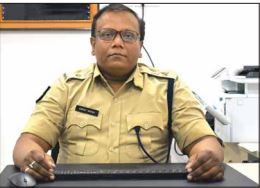
Bhangar Division: A Game Changer
The Bhangar Division within the Kolkata Police is the latest addition to its jurisdiction, being the youngest and newest station. Situated approximately 15 km away from the New Town area and in close proximity to the EM Bypass, Bhangar is emerging as a vital location. The newly formed Bhangar Division comprises eight police stations: Hatisala, Bhangar, Polerhat, Uttar Kashipur, Bijoyganj Bazar, Narayanpur, Bodra, and Chandaneswar. Efforts are currently underway on a war footing to develop infrastructure for these new police stations.
Bhangar is the 10th division of the Kolkata Police, spanning 232 sq km on Kolkata’s eastern fringes. The Division was deployed after the virtual inauguration by Smt Mamata Banerjee, the Hon’ble Chief Minister of West Bengal. IPS Saikat Ghosh has taken charge as the Deputy Commissioner (DC) of the Bhangar Division. Additionally, Middya Imamuddin has been appointed as the Officer-In-Charge (OC) of the newly established Bhangar Traffic Guard. Susanta Mondal will serve as the Officer-In-Charge of the Bhangar Police Station, while Amit Kumar Chatterjee will take on the role at the Uttar Kashipur Police Station. Sunil Debnath has been transferred to serve as the Officer-In-Charge of the Chandaneswar Police Station, and Sarfaraz Ahmed will take charge of the Polerhat Police Station. Furthermore, two Assistant Commissioners (AC) of the Kolkata Police have been assigned to Bhangar.
The regular operations of the Hatishala, Bijoyganj Bazar, Bodra and Madhabpur Police Stations under the Bhangar Division will function from Polerhat, Uttar Kashipur, Bhangar and Chandaneswar police stations respectively.
IPS Saikat Ghosh, Deputy Commissioner (DC) of Bhangar Division, Kolkata Police, remarked, “The inauguration of the Bhangar Division has created huge enthusiasm among the citizens here. We have received positive feedback from the local people. After all, Kolkata Police itself has created a benchmark with the services it provides. Since we are at the nascent stage, we have started with the necessities. Further infrastructural development work is underway. In the coming days, Bhangar Division will be at par with the other divisions of the Kolkata Police.”
The focus areas of the Bhangar Division are manifold. Firstly, the initiative aims to significantly improve the traffic situation in the Bhangar area, despite some parts being semi-rural, as the volume of vehicles remains high. Secondly, with the expertise of Kolkata Police personnel, there is an expectation of enhancing the law and order situation in the area. However, there are challenges to overcome. The geographical area covered by the Bhangar Division is larger than any other division of the Kolkata Police, posing logistical challenges. Additionally, there is ongoing work to address manpower, infrastructure, and equipment needs. Transitioning from State Police jurisdiction to Kolkata Police represents a significant paradigm shift. Nevertheless, there is optimism that improvements will continue, and the citizens are already applauding the measures undertaken by the Kolkata Police.
“One of the key areas we focus on is the community development programmes. These programmes, initiated by the Kolkata Police, have been highly popular over the years. We are eager to launch new initiatives where young people actively participate, including blood donation camps and employment-oriented projects. Our aim is to bridge the gap with citizens and address their needs effectively. We are constantly in touch with the citizens and have already received positive feedback indicating a reduction in crime rates. We are constantly in touch with the Lalbazar Headquarters to ensure effective collaboration. We are fully committed to providing quality services to the citizens of Bhangar for their well-being,” signed off IPS Saikat Ghosh, the dedicated and committed Deputy Commissioner of the Bhangar Division of Kolkata Police.
The Friendship Cup Football Tournament in the Bhangar Division, under the C Policing wing, has witnessed good crowds and active participation from the local youth. This year, 64 teams from the entire division have registered for this mega football tournament. Apart from that, the Kiran Project will be initiated soon in the Bhangar Division to provide various skill development training. One can only hope that in the coming days, the Bhangar Division will undergo a transformation for the betterment of the citizens.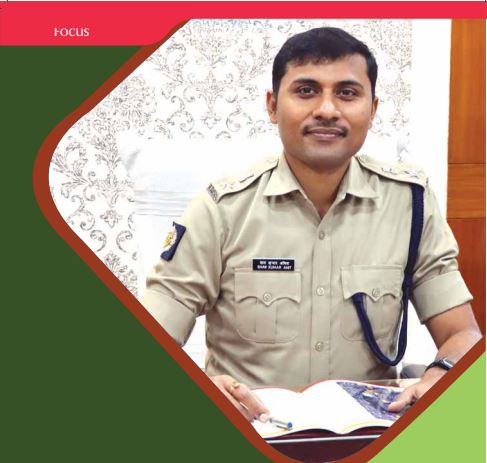
Deputy Commissioner of Police (DC) Amit Kumar Shaw: From Engineer to Super Cop
Deputy Commissioner of Police (DC) Amit Kumar Shaw: From Engineer to Super Cop
The Deputy Commissioner of Police (DC), Traffic Policing (South) Shri Amit Kumar Shaw, an erudite IPS officer, has shown how hardwork and endurance can transform life for the better.
Amit Kumar Shaw, an IPS officer, is like a character from a movie – tall, handsome, with a determined look, guided by idealism and a sense of duty for the nation. In reality, he is no different. A self-made man, IPS Amit Kumar Shaw has achieved success through hard work and commitment. In his own words, “I come from a middle-class area of Titagarh in Barrackpur. My parents, with limited exposure to education, made it a point to give me the best by other means. They got me admitted to nearby Douglas Memorial School, an English medium institution. I was never the top student, but I always gave my best.”
Preparing for the next level
After finishing school, Amit Kumar Shaw began preparing for the Joint Entrance Exam. He then enrolled at the Heritage College of Engineering, specialising in Information Technology. While in his third year of college, some of his friends encouraged him to pursue a career in civil services. “I believe that good companions can inspire you to make a big difference. I completed my engineering degree and joined Infosys, where I had a typical blue-collar job with a good salary. My parents were happy to see me settled. I moved to Chennai for work, but I felt the need to do something more and pursue my ambitions for the UPSC,” confessed IPS Amit Kumar Shaw candidly.
Leaping – A risk worth taking – The turning point
It is not easy to leave a settled corporate job, but fortune favours the brave. Amit Kumar Shaw left his job to focus completely on preparing for the Civil Services. From Chennai to Titagarh, he was back in the grind. In his first two attempts, he cleared the Preliminary rounds but did not do justice to his talent in the final round. In between, out of the blue, he cracked the WBCS examination and got the job at DSP. But God had different plans! Ultimately, even though he completed the training, he cleared the UPSC and joined the most prestigious job in the country – an IPS Officer in Civil Services. “I joined the training at Mussoorie and it was a completely different experience altogether. From day one, it was clear what the uniform wanted for me. No doubt, it was the best decision of my life to join the Civil Services,” confessed IPS Amit Kumar Shaw.
The beginning of an eventful journey
After completing the mandatory training, IPS Amit Kumar Shaw joined Cooch Behar. He then served as an ACP (Assistant Commissioner of Police) in the Howrah Commissionerate for two years. During this time, he demonstrated exceptional dedication and leadership, particularly during challenging situations such as Cyclone Amphan and the COVID-19 pandemic. His exemplary performance made him a role model for his colleagues and subordinates. Subsequently, he was assigned as an Additional Superintendent of Police in Malda, a challenging role that he handled with competence and responsibility. Amit Kumar Shaw’s proficiency as an IPS Officer was further evident when he assumed the position of Deputy Commissioner of Police, Traffic Police (South) in the Kolkata Police force.
Tackling the traffic menace scientifically
“Awareness and enforcement are crucial for modern-day traffic policing. It is undeniable that road traffic in this part of southern Kolkata involves various stakeholders such as school students, cyclists, pedestrians, two-wheelers, three-wheelers, as well as buses, taxis, and other modes of transport. Our focus has been on raising awareness among all these stakeholders. For instance, delivery services like Swiggy, Zomato, Blinkit, and others benefit from minimising delivery times, highlighting the importance of awareness and the right attitude towards driving in the busiest and most congested parts of the city,” emphasised Amit Kumar Shaw.
He emphasises on the importance of reducing fatalities. Under his leadership, various awareness programmes have been conducted across different platforms to educate and make stakeholders in the road traffic ecosystem more responsible. Additionally, drivers have undergone special training sessions to be more vigilant about issues such as blind spots while driving.
Technology, the key to success along with strong resource
Kolkata Traffic Police has adopted digital measures to reduce traffic violations and increase prosecution with credible digital evidence. Automatic Number Plate Recognition (ANPR) cameras have been installed at various strategic locations to read and digitalise vehicles’ number plates in real-time. Additionally, Red Light Violation Detection (RLVD) cameras have been installed to monitor the intersection after the signal has turned red. Increasing the coverage area with more cameras and ensuring the presence of qualified traffic personnel in their designated positions is crucial. Amit Kumar Shaw emphasises the importance of preventing encroachment on the roads to maintain smooth vehicular movement.
The ultimate success mantra
“Patience, focus, note-taking, and revision – this is the simple mantra for civil service aspirants. The sincerity to work makes someone a true professional and an asset to the organisation. At the end of the day, we are serving our country in our capacity, and that itself is the biggest motivation,” signed off Deputy Commissioner of Police, IPS Amit Kumar Shaw.
(As told to Ranabir Bhattacharyya, Team, The Kolkata PROTECTOR)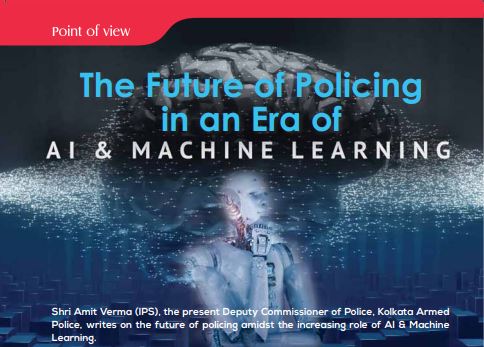
The Future of Policing in an Era of AI & Machine Learning
Shri Amit Verma (IPS), the present Deputy Commissioner of Police, Kolkata Armed Police, writes on the future of policing amidst the increasing role of AI & Machine Learning.
“Artificial intelligence will reach human levels by around 2029. Follow that out further to, say, 2045, we will have multiplied the intelligence, the human biological machine intelligence of our civilisation a billion-fold.”
~ Ray Kurzweil (Author, computer scientist, inventor and futurist).
The 21st century is characterised by significant technological advancements which are evolving exponentially. Whether it’s Large Language Models (LLMs) or quantum computing, these developments will greatly transform every aspect of life as we know it.
Artificial Intelligence (AI) could be defined as the simulation of human intelligence in computer systems and machines. It involves the development of algorithms, software and hardware that enable computer systems to perform tasks that usually require human intelligence, such as problem-solving, learning from experience, understanding natural language, recognising patterns, and making decisions.
The AI impact is going to be phenomenal in every field, including finance, cyber security, administration, etc. AI powered by quantum computing will have capabilities beyond known limits. It will revolutionise every field, including policing.
Machine Learning (ML) focuses on developing algorithms and statistical models that enable computers to perform tasks without explicit programming. Instead of relying on explicit instructions, ML algorithms learn from data, identifying patterns and making predictions or decisions based on that information.
Law enforcement agencies are increasingly using AI to improve their ability to uphold law and order and to detect and prevent crime. AI is being used to enhance efficiency and effectiveness, ensuring a safe and secure environment for citizens.
The Utility of Artificial Intelligence and Machine Learning in Modern Policing
1) Predictive and Evidence-based Policing
AI and ML algorithms can help analyse large amounts of crime data and other related data, especially past crime records. This will not only help predict potential crime hotspots but also allocate resources and implement appropriate strategies as per the past trend and pattern analysis resulting in optimal utilisation of resources.
2) Enhanced Investigative and Crime Analysis Abilities
AI provides the capability to analyse large amounts of data, including digital evidence, to find relevant information, much like finding a needle in a haystack. This results in faster investigations and increases the probability of solving cases. AI tools can thoroughly analyse the scene of a crime (SoC) and aid in better evidence collection, ultimately leading to higher conviction rates.
3) Natural Language Processing (NLP)
This will help analyse the cyber world, especially social media posts, to detect any crime or threat and ensure that the cyber world is safe and secure for the common citizens. It will help prevent rumour-mongering and the dissemination of false narratives.
4) Cybersecurity
Quantum-powered AI systems will revolutionise the way critical infrastructure and data are safeguarded from cyber threats. This will also help ensure that any threat to cyberspace is proactively detected and neutralised, providing a safe and secure cyber ecosystem for citizens.
5) Training
Training programmes and simulations could be made realistic. VR/AR/Metaverse will help provide realistic training scenarios and impart better training to police personnel.
Issues and Concerns
1) Ethical and Privacy Concerns
If AI systems have biases, it could lead to discrimination, especially against marginalised groups. Additionally, AI and ML tools needing large amounts of data may infringe on citizens’ civil liberties and privacy.
2) Transparency and Accountability
The complexities of AI systems will make transparency and accountability challenging for their decisions and actions.
3) Public Trust
Using complex systems without public participation or engagement could lead to a trust deficit between police authorities and common citizens.
4) Algorithmic Fairness
Fairness and impartiality in AI systems are crucial to ensure effective and sustainable citizen-centric usage of these tools. They must be designed to treat all individuals equitably, regardless of race, gender, caste, colour or socioeconomic status.
Way Forward
1) Transparency and Accountability
AI systems should be transparent and accountable to public institutions. Regular third-party audits should be conducted to ensure that the systems are unbiased and free from discrimination. Officers or agencies using AI must be held accountable for any wrongful actions or decisions resulting from these systems.
2) Public Engagement and Awareness
Developing a system where common citizens provide feedback and are actively engaged in ensuring systems are citizen-centric.
3) Data Privacy
Data protection laws should be formulated to handle sensitive information of the public.
4) Comprehensive Training
Comprehensive training for police personnel on these advanced systems to make them aware of their usage, including their limitations and potential biases.
5) Oversight and Regulation Mechanisms
Establishing an independent regulatory body needs to oversee AI systems usage in policing and ensure compliance with existing guidelines and regulations.
6) Ethical Framework
Establishing an ethical framework for the usage of advanced systems is crucial to ensure their ethical soundness and consistent adherence to ethical principles in all situations.
Conclusion
The Peelian Principles (Nine Principles of Policing) were developed by Sir Robert Peel, the founder of the Metropolitan Police Service in London in the early 19th century. These principles laid the foundation for modern policing and are still very much relevant today.
The Peelian Principles
1) The basic mission for which the police exist is to prevent crime and disorder.
2) The ability of the police to perform their duties is dependent upon public approval of police actions.
3) Police must secure the willing cooperation of the public in voluntary observance of the law to secure and maintain the respect of the public.
4) The level of public cooperation decreases as the need for physical force increases.
5) Police seek and preserve public favour not by catering to public opinion but by constantly demonstrating absolute impartial service to the law.
6) Police use physical force to the extent necessary to secure observance of the law or to restore order only when the exercise of persuasion, advice, and warning is found to be insufficient.
7) The police should always maintain a relationship with the public that reflects the idea that the police are part of the public and vice versa. Police officers are simply members of the public who are paid to dedicate their full-time attention to the responsibilities that every citizen has for the well-being and survival of the community.
8) Police should always direct their action strictly towards their functions and never appear to usurp the powers of the judiciary.
9) The test of police efficiency is the absence of crime and disorder, not the visible evidence of police action in dealing with it.
Technological advancements will completely transform the policing landscape. It’s crucial to consider the Peelian Principles when developing and using these systems.
Gandhiji rightly said that the future depends on what we do in the present. Currently, lawmakers, administrators, researchers, and law enforcement agencies must collaborate and cooperate in developing a strong ethical framework. This framework is essential to ensure that technologies are used ethically, with the sole purpose of providing a safe and secure ecosystem for the citizens. l
Amit Verma, IPS
Deputy Commissioner of Police
First Battalion
Kolkata Armed Police